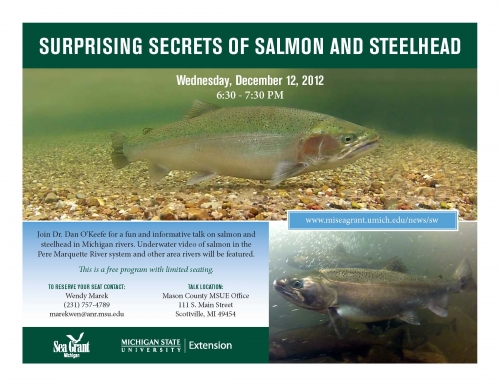Salmon and steelhead are focus of video presentation in Scottville
World-class fishing for salmon and steelhead is the norm in Mason County, but few people get the chance for a fish-eye view of what swims in local waters.
Anglers, teachers, nature lovers, and students have the opportunity to learn about salmon and steelhead on Dec. 12 at the Michigan State University Extension office at 111 S. Main St. in Scottville, Mich. Underwater video from local streams and lakes will provide the backdrop for fun facts about fish and discussion of how they perceive their environment. Dr. Dan O’Keefe of Michigan Sea Grant will lead the program and field questions.
Salmon have a unique life cycle that ends (and begins) with the migration of adult fish into streams where they spawn and die. The
annual spawning run provides an amazing spectacle as  huge fish enter clear, shallow water that offers perfect conditions for their eggs. Female salmon dig
nests called redds using their tails while male salmon fight and jockey for position near active redds.
huge fish enter clear, shallow water that offers perfect conditions for their eggs. Female salmon dig
nests called redds using their tails while male salmon fight and jockey for position near active redds.
Why does this explosion of life end with the inevitable death of parent fish? Why do some tiny males mature early, even though this means that they will die young? Why don’t our Great Lakes salmon get as big as the giant king salmon of Alaska? These are some of the questions associated with these familiar, but enigmatic fish.
Anglers will also pick up some tips on how salmon and steelhead locate prey, when and why they feed, and how they interact with other fish species in river and lake environments. Although these species are not native, they have established breeding populations in many rivers. They also feed on invasive prey fish and offer fisheries managers some degree of control when attempting to balance Great Lakes ecosystems that are changing dramatically as other invaders expand and multiply.
The round goby is a new invader in local rivers. They are known egg predators that have only recently moved into prime salmon spawning areas. In addition to learning about salmon, attendees will learn how to identify round goby and report new sightings so that scientists can track their spread into trout streams and determine their effects.
This program is free and open to the public, but seating is limited. Call ahead to register with Wendy Marek at (231) 757-4789.



 Print
Print Email
Email




